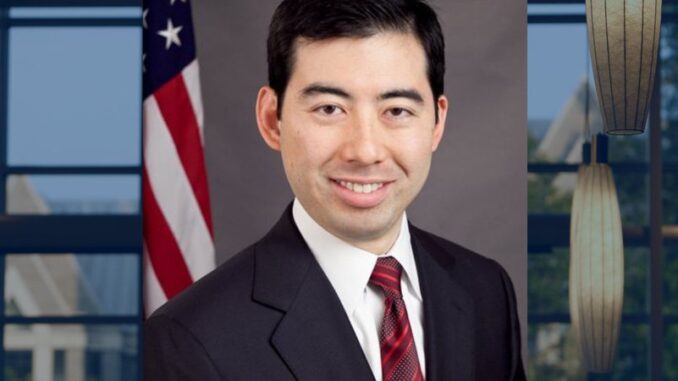
Projects the increase in public companies’ regulatory reporting costs from about $2 billion to $8.4 billion per year.
Mark Uyeda, the SEC Commissioner, spoke at the Cato Summit, a conference of the libertarian Cato Institute, in Washington DC Thursday November 18. In short, the SEC commissioner said the increase in public companies’ regulatory reporting costs from about $2 billion to $8.4 billion per year, will create more uncertainty about the long-term viability of environmental, societal and governance (ESG) focused investing.
The conference session entitled, “The Rise of ESG and the Future of Financial Regulation”, raised several problems regarding ESG along with more momentum in spending money to solve the ESG Issues that now exist.
“Whether these trends can be sustained over the long run is an open question, especially if many of these ESG funds are essentially plays on overweighting the technology sector and underweighting the energy sector,” he said. “Not surprisingly, one need look no further than rating agencies, whose evaluations reflect widespread disagreement. It could simply reflect that ESG factors are so individualistic. It is difficult to consistently calibrate ESG on a uniform basis.”
A recent MIT study found the average correlation between six of the “top” ESG rating agencies to be just 54% compared to 99% for the “top” credit agencies.
The conference seemed to focus more on the spending money as the solution to achieve ESG Profits. Uyeda said that the SEC, which has regulatory powers over about 4,266 U.S. public companies, found in a March survey that it costs U.S. companies a total of about $2 billion per year to file their S1 forms and annual reports to the agency. Subsequent studies have shown that amount would rise to $8.4 billion if the SEC enacts a series of proposed ESG reporting rules that are under consideration.
“Even that amount may be too low because it assumes legal costs of $600 per hour,” Uyeda said. “There will be increased costs and these costs will be ultimately born by investors.”
And there you have it. Subjective control over emissions, climate change, transgender issues, public-private partnerships, Meatless Mondays and tree planting scams are ultimately pinned on the investors. They make the rules, and the investors have to pay.
Transcript from the 2022 Cato Summit on Financial Regulation (Washington D.C.)
Commissioner Mark T. Uyeda
Nov. 17, 2022
Thank you, Jennifer [Schulp], for the kind introduction. Good morning to everyone here in person and those participating virtually. I appreciate being part of your conference focusing on the rise of environmental, social, and governance (ESG) investing and the future of financial regulation. The conference raises a number of important questions, such as “what is ESG?,” “what role should ESG play in investment decisions?,” and “should ESG be considered in assessing financial stability?” As you consider these issues, I wanted to share some thoughts that reflect my individual views as a Commissioner and do not necessarily reflect the views of the full Commission or my fellow Commissioners.
I. Sustainability of ESG Investing
First, let’s discuss ESG and sustainability – but I am not referring to ESG and sustainability as interchangeable terms. Rather, the terms are meant to ask whether ESG investing, in its current form, is itself sustainable. The asset management industry has excelled in recent years in attracting fund flows to ESG-themed investment products. Whether these trends can be sustained over the long run is an open question, especially if many ESG funds are essentially plays on over-weighting the technology sector while under-weighting the energy sector. Meanwhile, on the corporate disclosure side, it is appropriate to inquire whether a specific E, S, or G factor will remain relevant in the future.
A. Disagreement on what is ESG
When evaluating whether any activity can be maintained, one should think about whether the long-term benefits outweigh the costs. For instance, the financial impact on enterprise valuations for various factors in the “G” category – such as the use of dual-class stock and classified boards of directors – have been known for a long time.[4] However, for ESG as a whole, whether there is a net benefit may be difficult to evaluate because interested persons may not agree on what particular factors constitute ESG, much less on how much weight each factor should be given. For example, the Commission has a pending stock buyback rulemaking proposal.[5] Should that disclosure be considered a “G” factor? Or an “S” factor? Or both? Or neither? Reasonable persons could reach different conclusions.
Not surprisingly, one need look no further than the so-called ESG rating agencies, whose evaluations reflect widespread disagreement. A recent study by professors at the Massachusetts Institute of Technology and the University of Zurich found that the average correlation among six prominent ESG rating agencies to be 54%, compared to 99% among credit rating agencies. This study showed that the divergence in ESG ratings was due mostly to how rating agencies measure company data, followed by differences in the attributes assessed, and the weighting of those attributes. One should not necessarily view the lack of correlation as a bad thing; to the contrary, it could simply reflect that ESG factors are so individualistic, it is difficult to consistently calibrate ESG on a uniform basis.
B. Additional Costs Seem Certain
Despite these disagreements on what constitutes ESG, one aspect seems certain – there will be increased costs and these costs will be ultimately borne by investors. As an example, one should look at the estimated costs associated with the Commission’s proposed climate-related disclosure. In its March 2022 proposal, the Commission estimated that the total existing external cost burden on companies to register their offerings on Form S-1 and file their annual reports on Form 10-K was a little more than $2 billion. The Commission then estimated that the marginal increase from the proposed climate disclosures alone would nearly triple these costs to over $6.3 billion. These estimates were based on the assumption that the cost for external legal advice was $400 per hour – an amount that has remained flat since 2006. Recently, the SEC adjusted the assumed cost to $600 per hour – and even this revision may be too low. Using this $600 assumption, the total estimated external costs quadruples to $8.4 billion.
One aspect of costs for ESG that may differ from costs associated with other disclosure rules is the potential difficulty for companies to achieve cost efficiencies or economies of scale in preparing ESG disclosures. In the climate-related disclosure proposal, the SEC assumed that compliance costs may decrease after the first year.[13] This assumption may or may not be true. The SEC’s proposal permits the use of reasonable estimates, but in the future, technology may be developed allowing for more precise capture of greenhouse gas (GHG) emissions that may entail additional costs. Furthermore, companies may have costs arising from other ESG obligations.
Today, some persons, including non-investor ESG stakeholders, are focused on climate and GHG emissions. However, in the next few years, that focus could shift to other disclosures, such as water-related metrics or other topics that are not currently contemplated. This ever-changing focus of ESG, combined with a lack of consensus on what constitutes ESG, could make it difficult for companies to decrease compliance costs over time.
C. Additional Benefits are Uncertain
Unlike costs, which can be measured and quantified to some degree, the benefits of ESG investing can be more difficult to quantify. Even where quantifiable, the results are mixed. A study by two Vanguard investment strategists concluded that ESG funds have neither systematically higher nor systematically lower raw returns or risk than the broader market. In contrast, a study by a sustainability data firm found that funds weighted towards companies with positive ESG scores outperformed the unweighted benchmark. However, focusing on the portfolio consisting of North American companies, the excess returns were only 0.17%. Further, when broken down by E, S, and G categories, portfolios with strong governance metrics outperformed the benchmark by the most, at 0.70%, followed by portfolios with strong environmental metrics at 0.28%. In contrast, portfolios with strong social metrics underperformed the benchmark by 1.29%.
D. Investors Should Assess the Sustainability of ESG Investing
The uncertainty of benefits associated with ESG investing, combined with the certainty of costs for companies undertaking ESG activities, should motivate all market participants – whether public companies, investors, or asset managers – to question whether the ESG trend itself is sustainable over the long term. But as a starting point, it could be useful to define what exactly is ESG. Otherwise, it is difficult to implement a disclosure regime that is consistent, comparable, and decision-useful when ESG factors and weightings are all in the eye of the beholder.
II. Disclosure of Asset Managers’ Engagement Efforts
One aspect of ESG investing, which is employed even with respect to certain non-ESG themed funds, is the idea of stewardship and engagement by asset managers with public companies. Specifically, some asset managers conduct extensive stewardship activities, even when their funds are marketed as “passive” or “index-tracking” investments. Companies often engage with these asset managers because of the influence and leverage that asset managers can have, as the funds advised by the asset managers hold the companies’ voting securities. In the SEC regulatory regime, these asset managers are said to have “beneficial ownership” of companies’ voting securities because they have the power to vote, or to direct the voting of, such securities. If that beneficial ownership exceeds five percent, then asset managers are required to publicly report their ownership.
Congress created this reporting regime in 1968 to “provide information to the public and the subject company about accumulations of its equity securities in the hands of persons who then would have the potential to change or influence control of the issuer.” Initially, all persons beneficially owning more than five percent of a public company were required to report their ownership on a Schedule 13D. In 1977, pursuant to its rulemaking authority, the SEC began permitting certain categories of institutional investors to report their ownership on a shorter form. This form – initially called Schedule 13D-5 and now called Schedule 13G – requires less disclosure about the beneficial owner, is less costly to prepare, does not need to be initially filed as quickly, and does not need to be updated as frequently, when compared to Schedule 13D.
A. Asset Managers’ Use of Schedule 13G
Asset managers registered with the Commission under the Investment Advisers Act of 1940 are permitted to report on Schedule 13G if they satisfy two conditions. First, they must have acquired the securities in the ordinary course of their business. Second, they must not have acquired, and do not hold, the securities with the purpose or effect of changing or influencing the control of the issuer of the securities or in connection with, or as a participant in, any transaction having such purpose or effect. While there are not precise statistics comparing asset managers’ use of Schedule 13D versus Schedule 13G, my observation is that asset managers responsible for the largest mutual fund and ETF complexes nearly all report on the latter, implying that they believe both conditions are satisfied.
B. Asset Managers’ ESG Stewardship and Voting in Director Elections
In reviewing any large asset manager’s stewardship website, mentions of ESG seem ubiquitous, from voting guidelines to engagements statistics. The information on these websites often document how an asset manager establishes its expectations for ESG matters, engages with companies that aren’t meeting its expectations, and may vote against one or more incumbent directors if those companies do not continue to meet expectations. For example, an asset manager publicly disclosed a case study where, following multi-year engagements, it voted against a director of a public company, who also chaired the board committee overseeing ESG matters, because the company had failed to disclose its forward-looking GHG reduction targets. This is one of many instances in which an asset manager did not support the election of a director on the basis of climate-related issues.
C. Asset Managers’ Control Intent or Lack Thereof
The second condition for Schedule 13G eligibility requires that the asset manager must not have control intent with respect to the company. With respect to stewardship, does an asset manager truly lack control intent? The SEC staff has provided guidance that an asset manager’s engagement with a company’s management on social or public interest issues, including environmental policies, without more, would not preclude the asset manager from filing on Schedule 13G so long as the engagement is not undertaken with the purpose or effect of changing or influencing control of the company. However, this guidance does not answer the question. The guidance merely reiterates that the asset manager cannot take any action with the purpose or effect of changing or influencing control. If an asset manager develops ESG policies, meets with companies to discuss how they are not following such policies, and then votes against directors because the company’s ESG practices do not match the asset manager’s policies, has that asset manager done more than simply engage?
Furthermore, the staff guidance appears based on statements made in the Commission’s 1998 release adopting amendments to Regulation 13D-G. However, a very important change in corporate governance has occurred since then. In 1998, most board directors were elected by a plurality vote, and proxy cards generally contained the voting choices of “for” or “withhold.” Thus, the receipt of a single “for” vote was sufficient to elect a director in an uncontested election. Today, in contrast, a significant number of public companies have adopted some form of a majority voting provision in uncontested elections, and directors may not be elected if they receive more “against” votes than “for” votes. Thus, the consequences of a company’s engagement with asset managers are very different today than in 1998, as an asset manager’s voting decision can be much more consequential.
With respect to whether an asset manager’s engagement has the purpose or effect of changing or influencing “control” of the company, the SEC has provided a definition of “control” under the Securities Exchange Act, which means the power to direct or cause the direction of the management and policies of a company. A company’s ESG practices can include, among other things, its ESG strategy and goals, the timeline on which to execute, how much resources to dedicate to achieving its goals, and how much voluntary disclosure it provides with respect to the foregoing. All of these activities might be reasonably considered to be part of the “management and policies” of a company. A company’s board, and particularly the members on a committee overseeing ESG matters, may have the power to direct or cause the direction of the company’s ESG practices. So can an asset manager’s stewardship and engagement activities – with the implicit threat of voting against a director standing for re-election – be described as having the purpose or effect of changing or influencing control of the company? In my view, that is an open question.
D. Disclosure of Asset Managers’ Plans or Proposals for Director Elections
Even if an asset manager is determined not to have control intent – and therefore eligible to use Schedule 13G – the Commission should consider whether additional and more timely disclosure of the asset manager’s discussions with a company’s management and its voting intent should be required, either on Schedule 13G or elsewhere.
Regulation FD regulates the disclosure by a public company of material, non-public information provided to an asset manager. However, other than Schedule 13D, there is no requirement that an asset manager beneficially owning more than five percent of a company’s voting securities disclose its communications with that company on ESG matters. To the extent that asset managers are not required to file on Schedule 13D, this dichotomy in disclosure obligations between a company and an asset manager seems at odds with a disclosure regime aimed at providing material information to all shareholders.
Another way to look at this issue is to consider a “traditional” activist shareholder that develops a financial model showing that a company would create more value for its shareholders by spinning off a business unit. The activist shareholder then approaches the company with its idea and suggests that it would vote against one or more incumbent directors if the company does not carry out its idea. If the activist shareholder beneficially owns more than five percent of the company’s voting securities, then it would be generally expected to file a Schedule 13D and disclose its discussions with management. Thus, why should the conclusion be different when it is the asset manager for a large mutual fund or ETF complex and the idea involves ESG matters instead of a spin-off?
III. Conclusion
In conclusion, ESG investing has been a trending topic for the past several years. As with any new trend, market participants should evaluate how their activities within this space are consistent with their legal obligations, including any applicable fiduciary duties. Additionally, the Commission should consider whether current rules capture the activities and behavior associated with the new trend, particularly with the efforts of significant shareholders to change or influence the management and policies of public companies. If so, the Commission should enforce those rules, and if not, then the Commission should evaluate whether an update to those rules is needed.
Thank you, and I hope you enjoy the rest of today’s conference.
About The Crude Life
Award winning interviewer and broadcast journalist Jason Spiess and Content Correspondents engage with the industry’s best thinkers, writers, politicians, business leaders, scientists, entertainers, community leaders, cafe owners and other newsmakers in one-on-one interviews and round table discussions.
The Crude Life has been broadcasting on radio stations since 2012 and posts all updates and interviews on The Crude Life Social Media Network.
Everyday your story is being told by someone. Who is telling your story? Who are you telling your story to?
#thecrudelife promotes a culture of inclusion and respect through interviews, content creation, live events and partnerships that educate, enrich, and empower people to create a positive social environment for all, regardless of age, race, religion, sexual orientation, or physical or intellectual ability.
Sponsors, Music and Other Show Notes

Studio Sponsor: The Industrial Forest
The Industrial Forest is a network of environmentally minded and socially conscious businesses that are using industrial innovations to build a network of sustainable forests across the United States.
Weekly Sponsor: Stephen Heins, The Practical Environmentalist
Historically, Heins has been a writer on subjects ranging from broadband and the US electricity grid, to environmental, energy and regulatory topics.
Heins is also a vocal advocate of the Internet of Everything, free trade, and global issues affecting the third of our planet that still lives in abject poverty.
Heins is troubled by the Carbon Tax, Cap & Trade, Carbon Offsets and Carbon Credits, because he questions their efficacy in solving the climate problem, are too gamable by rent seekers, and are fraught with unreliable accounting.
Heins worries that climate and other environmental reporting in the US and Europe has become too politicized, ignores the essential role carbon-based energy continues to play in the lives of billions, demonizes the promise and practicality of Nuclear Energy and cheerleads for renewable energy sources that cannot solve the real world problems of scarcity and poverty.

Weekly Sponsor: Great American Mining Co
Great American Mining monetizes wasted, stranded and undervalued gas throughout the oil and gas industry by using it as a power generation source for bitcoin mining. We bring the market and our expertise to the molecule. Our solutions make producers more efficient and profitable while helping to reduce flaring and venting throughout the oil and gas value chain.

Join Podcasters from across the world and all walks of life as they unite to bring civil solutions to life and liberty.

Studio Email and Inbox Sponsor: To Be Announced

Featured Music: Alma Cook
For guest, band or show topic requests, email studio@thecrudelife.com
Spread the word. Support the industry. Share the energy.


